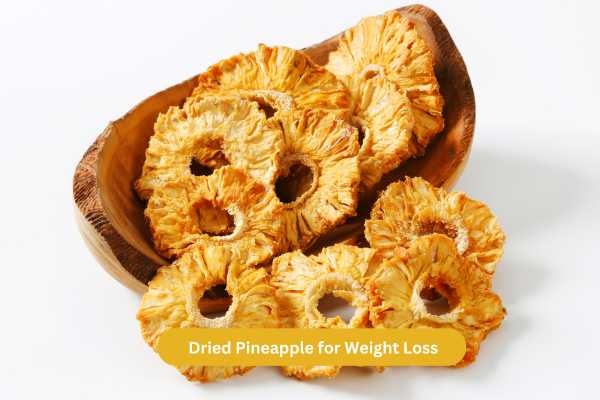Dried pineapple is one of those snacks that feels like a treat but is often marketed as a healthy alternative to sweets. With its chewy texture and tropical sweetness, it’s easy to see why many in the UK are reaching for it as a quick energy booster or post-gym snack. But when it comes to weight loss, is dried pineapple truly a miracle food or just another sugary temptation in disguise?

In this article, we’ll take a closer look at the nutritional profile of dried pineapple, its potential benefits, and the truth about whether it helps—or hinders—your weight loss goals.
What Exactly Is Dried Pineapple?
Dried pineapple is made by dehydrating fresh pineapple slices until most of their water content evaporates. This process preserves the fruit for longer while concentrating its natural sugars and flavours. The result is a chewy, sweet, and shelf-stable snack that’s popular in lunchboxes, trail mixes, and health food shops across the UK.
While it retains many of the vitamins and minerals found in fresh pineapple, the drying process significantly changes its calorie and sugar density. Understanding these differences is key to determining its role in a healthy diet.
Nutritional Breakdown of Dried Pineapple
A 30-gram serving of dried pineapple typically contains:
-
Calories: 100–120
-
Sugar: 20–25 grams
-
Fibre: 2–3 grams
-
Vitamin C: Moderate (though less than in fresh pineapple)
-
Manganese and Copper: Present in beneficial amounts
Dried pineapple is rich in natural sugars, which provide a quick energy boost—ideal for athletes or those needing a fast pick-me-up. However, that same sweetness can work against those trying to reduce calorie intake.
The Weight Loss Argument: The Case For Dried Pineapple
Despite its sugar content, there are several reasons why dried pineapple can still be part of a balanced weight loss plan when consumed sensibly.
1. A Healthier Alternative to Processed Sweets
For people who crave sugary snacks, dried pineapple offers a more natural option. Unlike chocolate bars or sweets filled with refined sugars and additives, dried pineapple delivers natural fruit sugars alongside fibre, vitamins, and minerals.
2. Rich in Fibre
Fibre helps keep you feeling full for longer, preventing overeating and snacking between meals. While the drying process reduces overall fibre compared to fresh fruit, dried pineapple still contains enough to contribute to daily fibre intake, supporting digestive health and appetite control.
3. Supports Digestion
Pineapple contains bromelain, an enzyme that aids digestion and may help reduce bloating. Though bromelain levels decrease with drying, traces remain, which can still provide mild digestive benefits.
4. Convenience for Busy Lifestyles
Many UK adults struggle to maintain healthy eating habits due to busy work schedules. Dried pineapple is portable, mess-free, and doesn’t spoil quickly, making it an easy option for on-the-go snacking. This convenience can help people avoid less healthy fast-food options.
The Weight Loss Argument: The Case Against Dried Pineapple
While dried pineapple has its merits, there are valid reasons to be cautious if your main goal is losing weight.
1. High in Sugar and Calories
When pineapple is dried, its natural sugars become concentrated. A handful of dried pineapple can contain the same amount of sugar as several slices of fresh pineapple. This means it’s easy to overeat and unknowingly consume more calories than intended.
2. Possible Added Sugars
Many commercial dried pineapples are coated with extra sugar or syrup to enhance sweetness. This added sugar not only increases calorie count but can also spike blood sugar levels, making it less ideal for those managing weight or diabetes. Always check the label for terms like “sweetened” or “candied.”
3. Reduced Satiety
Because dried pineapple is smaller in volume than fresh fruit, it doesn’t fill you up as much. This can lead to consuming more before feeling satisfied, which adds unnecessary calories to your diet.
How to Include Dried Pineapple in a Weight-Conscious Diet
If you love dried pineapple and don’t want to give it up, the good news is you don’t have to. The key is moderation and mindfulness.
1. Watch Your Portions
Limit your portion size to a small handful (about 25–30 grams). This provides flavour and energy without going overboard on sugar and calories.
2. Choose Unsweetened Varieties
Always opt for unsweetened, sulphite-free dried pineapple. These versions contain only natural fruit sugars and fewer additives.
3. Combine with Protein or Healthy Fats
Pair dried pineapple with nuts, seeds, or yoghurt. This combination helps balance blood sugar levels and keeps you fuller for longer.
4. Use It as a Natural Sweetener
Instead of snacking directly on dried pineapple, use small pieces to naturally sweeten porridge, overnight oats, or homemade granola. You’ll still enjoy its tropical flavour without overindulging.
A Balanced Perspective
So, is dried pineapple a myth or a miracle when it comes to weight loss? The answer lies somewhere in between. It’s not a magic solution for shedding pounds, but neither is it a forbidden food. When enjoyed mindfully and as part of a balanced diet, dried pineapple can offer a healthier alternative to refined sweets while providing natural energy and valuable nutrients.
Weight loss success ultimately depends on overall calorie control, nutrient balance, and consistent healthy habits—not a single food. Dried pineapple can fit within that framework as a small, enjoyable indulgence that doesn’t derail your goals.
Final Thoughts
Dried pineapple can be a smart, satisfying snack when used wisely. Its sweet, tropical taste makes it a great alternative to processed treats, but portion control is essential. For those in the UK aiming to maintain or lose weight, the key is to treat dried pineapple as an occasional complement to a balanced diet—not a daily staple.
Enjoy it mindfully, stay active, and focus on a variety of whole foods. With the right approach, dried pineapple can be a small yet delightful part of your journey toward healthier eating.

